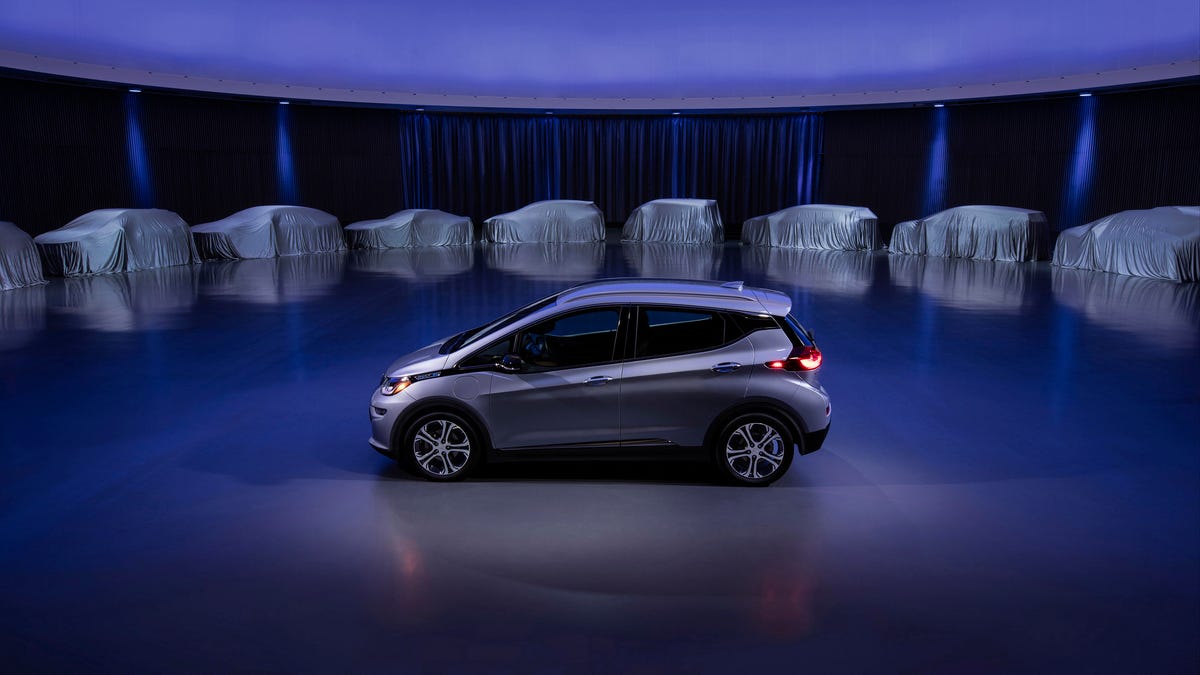GM announces two new EVs in next 18 months, shows fuel-cell vehicle
A pair of new electric cars based on Chevrolet's Bolt EV are in the near-term pipeline, and a future-think fuel-cell concept stokes visions of a hydrogen future.

As part of its bid to transition its business from fossil fuels and embrace a zero-emissions, zero-crash and zero-congestion future, General Motors revealed new details of its roadmap to electrification on Monday. Announced at its Design Dome in Warren, Michigan, GM's plan includes two new all-electric production vehicles for the US market in the next 18 months. These two unnamed models will be "based off learnings" from the Chevrolet Bolt EV, and they're part of a larger plan to launch at least 20 new electric vehicles globally by 2023.
Although GM declined to confirm it, one of those two models is widely expected to be a traditional crossover SUV. (Chevrolet has been marketing its Bolt EV as a crossover, but most consumers seem to view it as a conventional hatchback).
While a majority of the aforementioned 20 vehicle launches will undoubtedly be battery electric, Mark Reuss, GM's executive vice president of product development, purchasing and supply chain, told members of the media, "General Motors believes in an all-electric future... Our electric solution cannot be 'one size fits all.' We believe you need two different flavors of electrification — battery electric and fuel cell electric."
GM showed media three of the concepts under those sheets, but sadly won't share them with you...
In conjunction with Monday's announcement, GM showed media the SURUS — Silent Utility Rover Universal Superstructure — a bold concept that thematically resurrects the skateboard-like hydrogen fuel cell mechanicals of its 2003 Hy-Wire show car, placing a large-scale on an off-road-capable heavy-duty truck frame. The chassis concept features a pair of electric motors, all-wheel steering and fully autonomous operation.
GM is so far declining to release images of the SURUS, but imagine a bare chassis that could form the basis of a commercial truck, large ambulance or even a mobile power generator station, and you've got it. While the automaker showed media members the bare architecture, it showed renderings of all three possible usage cases. Perhaps not coincidentally, the latter configuration in particular would seem to be ideal for coping with the fallout from natural disasters like Hurricane Maria in Puerto Rico.
GM's 2003 Hy-Wire featured a skateboard-like hydrogen fuel-cell chassis that is thematically similar to the new SURUS concept showed to media on Monday.
While not committing to a production version of the SURUS concept, GM has already stated it will begin commercial production of fuel cell stacks in 2020 at its Brownstown, MI plant, and the US military is testing its Colorado ZH2 off-road fuel cell pickup truck. GM has been participating in a joint-venture fuel-cell development project with Honda since 2013, and an unspecified retail fuel cell vehicle is promised within five years.
SURUS wasn't the only vehicle that GM revealed on Monday, it also showed a trio of unnamed full-size clay design studies. Part of a larger grouping of nine vehicles under sheets, the three revealed concepts included a handsome small Buick-branded SUV (that looks a fair bit like Volvo's new XC40), as well as a larger Cadillac-badged vehicle that visually bridges the gap between crossover and station wagon. Finally, GM also pulled the covers off a Chevrolet Bolt-branded pod-like monospace concept that looked like an autonomous shuttle concept. GM didn't leave the vehicles uncovered for long, and Reuss and other company officials declined to say whether any of them were production-bound vehicles, or indeed, if they'd ever even be publicly shown at all.
Reuss says GM knows that whether consumers are interested in battery-electric or hydrogen fuel cell power, a big part of the drive to increase acceptance of these new vehicles hinges upon infrastructure. GM is investigating ways to promote additional EV charging points and hydrogen filling stations, but thus far, it has nothing to announce in terms of devoting new resources to the effort.

